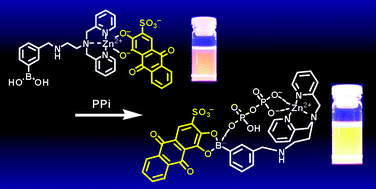A new strategy for the fluorescent detection of multi-phosphates in aqueous solution is presented here. ZnII–DPA(DPA = dipicolylamine)-appended phenylboronic acid 1·Zn forms an assembly with alizarin dye in MeOH–10 mM HEPES (1 : 1 v/v) containing 10 mM NaCl at pH 7.4 at 25 °C, in which the dye binds favorably to the coordinated zinc(II) in the ZnII–DPA moiety. Addition of pyrophosphate (PPi) as a putative analyte causes reorganization of the complex to produce an alternative boronate ester assembly, which causes an increase in fluorescence, detectable by the naked eye. It is interesting to note that the system exhibited PPi-selectivity over other phosphates such as ATP (adenosine 5′-triphosphate), ADP (adenosine 5′-diphosphate), AMP (adenosine 5′-monophosphate) and Pi (inorganic phosphate); the competitive assay employed to determine the apparent association constants of 1·Zn with the anion analytes allows us to estimate that the binding with PPi [(1.6 ± 0.04) × 106 M−1], is 10-fold and 84-fold higher than with ATP and ADP, respectively. The sensing mechanism of 1·Zn in the presence of alizarin dye is explored using pH titrations and structural information is obtained using NMR.

You have access to this article
 Please wait while we load your content...
Something went wrong. Try again?
Please wait while we load your content...
Something went wrong. Try again?


 Please wait while we load your content...
Please wait while we load your content...